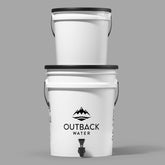Quiz 2 - Water Chemistry
Water Chemistry - Quiz #2
-
We know that the chemical composition of water is H2O (two hydrogen atoms and one oxygen atom). Therefore it follows that hydrogen accounts for nearly 70% of the molecular weight of water. True or False?
-
Water is called the “universal solvent”. True or False?
-
The pH indicates how much water weighs. True or False?
-
Water typically boils at a lower temperature at higher altitudes. True or False?
-
Ice floats on water. True or False?
-
All substances are water soluble. True or False?
-
Sea water does not freeze. True or False?
-
Fresh water has a lower freezing point than saltwater. True or False?
-
A water molecule weighs 8.6 grams. True or False?
-
One gallon of fresh water weights 5 .75 lbs. True or False?
Answers to Water Chemistry - Quiz #2
-
False: The hydrogen atom weighs one-sixteenth of an oxygen atom, in a water molecule 88.8% of the total weight is from oxygen, while 11.2% belongs to the hydrogen.
-
True: Water has the capacity to dissolve more substances than any other liquid, making it commonly referred to as the universal solvent. The universal solvent quality of water allows it to take other valuable minerals, nutrients, or chemicals with it wherever it may flow. The polar bonds in the water molecule make it a universal solvent.
-
False: pH has nothing to do with water weight but instead is a scale that runs from 1-14, where a pH of 1-6 refers to a solution in an acidic state, pH 8-14 in a base state and 7 being neutral. The pH of a chemical substance is determined by the number of hydrogen atoms contained within the substance. So a chemical compound with a high pH of 8-14 has a high number of hydrogen atoms in its chemical composition and are considered alkaline/base. Where compounds containing a lower number of hydrogen atoms fall in the 1-6 and are considered acidic.
-
True: The boiling point of water is lower at higher altitudes due to the decreased air pressure.
-
True: Ice does float. When a substance freezes the molecules generally come closer together. Water is different, it freezes below 00C, but when the water goes below 40C water starts to expand again and as a result the density becomes lower. Density of a substance means the weight in kilograms of a cubic meter of substance. So when two substances are mixed but do not dissolve in one another, the substance with the lower density floats on the other substance. In this case that substance is ice, due to the decreased density of water.
-
False: Polarity determines if a substance is water-soluble. A polar substance is a substance that has two kinds of “poles”, as in a magnet. When another substance is also polar of the poles of the substances attract each other, and as a result the substances mix. A substance then dissolves in water. Substances that contain no “poles are called a-polar substances. Oil for instance is an a-polar substance, which is why oil does not dissolve in water. In fact it floats on water, just like ice, due to its smaller density.
-
False: The temperature at which sea water freezes varies. Salt water freezes at a different temperature than fresh or pure water. The freezing temperature for salt water depends on the concentration or how much salt is present in the water. The more salt (higher the concentration) the lower the freezing temperature will be. Typical sea water that is not close to a glacier, rivers or any other type of fresh water inlet contains about 35 g of salt per 1,000 units of water. Under these conditions salt water will freeze at approx. 1.910C.
-
False: Salt water (NaCl) freezes at a lower temperature than pure water (H2O) due to the chemical characteristics of both. Normally for water to freeze, the H and O need to bond. With the presence of salt in the water it makes it harder for the H and O to bond together. The salt does not naturally want to bond with ice and as the salt particles replace the water particles, the rate of freezing is much lower.
-
False: The weight of a molecule is determined by the atomic weights of the atoms from which it is constructed. The atomic mass of an atom is determined by the masses of the protons and neutrons in the nucleus of the atom. The electrons have little effect as they weigh so very little. When the atomic masses of the separate atoms are known , one simply needs to add them up to find the total atomic mass of the molecule, expressed as gram per molecule. An example would be H20 (water). Hydrogen has a relative atomic mass of 1 gram/molecule and Oxygen has a relative mass of 16 grams/molecule. Water has one Oxygen atom and two Hydrogen atoms: 16 + 1 +1 = 18 grams/molecule would be waters atomic weight.
-
False: One US gallon of water weighs approx 8.34 lbs, one imperial gallon 10.0 lbs and one US gallon of sea water 8.56 lbs.
- Choosing a selection results in a full page refresh.





